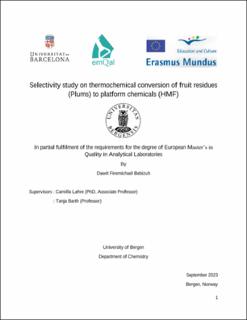| dc.description.abstract | 5-hydroxymethylfurfural (HMF) is one of the versatile platform compounds derived from the dehydration of carbohydrates originating from biomass. However, the non-selective production of HMF from carbohydrates and its subsequent separation from the solvents remains challenging. Hence, the present thesis takes a systematic approach to understanding the conversion of Plum biomass to HMF and leverages this knowledge to propose strategies for improving conversion selectivity and HMF yield. The focus lies on optimizing the effect of conversion variables and developing an analytical strategy to characterize the feedstock (Plum) and product fraction. A rapid and robust selective ion monitoring (SIM) based LC-ESI-MS/MS method using analytical quality by design (AQbD) principles was developed for the simultaneous analysis of sugars and HMF. The developed method has been successfully applied to quantify sugar and HMF in Plum biomass before and after thermochemical conversion. The technique demonstrated high sensitivity, selectivity, throughput, and accuracy, with recovery ( 91% to 103%), limits of detection (0.11 to 1.72 μg/mL ), and coefficients of variation (1.2 to 2.0%). Calibration curves for all analytes were linear with R2 values greater than 0.991. Plum biomass has a high moisture content (78 ± 4%), and 84% of its dry weight is covered by sugar. Glucose and fructose were found to be the dominant monosaccharide, 47% and 19% based on the dry weight basis, respectively. A simple, fast, and efficient process for HMF production from Plum's samples was developed, where sulfamic acid and MIBK were used as a catalyst and solvents under conventional heating. The critical reaction parameters, including substrate load, temperature, and aqueous phase percentage were optimized using definitive screen design (DSD) followed by central composite design (CCD). A higher HMF yield (32%), selectivity (~51%), and sugar conversion (~93%) were achieved at optimal reaction conditions (temperature (210 0C), aqueous phase (30 %V), time (120 min), sulfamic acid load (0.01 g), and substrate load (0.1 g)). The relative error between the experimental and predicted response for HMF selectivity and product (HMF) yield was found to be in the acceptable range (< 2%). In conclusion, the low-cost catalyst and solvent system, the practical and environmentally friendly reaction conditions, and the simple procedure provided in this study confirmed that the proposed strategy and feedstock are very efficient for HMF production. However, further study on the isolation and purification of the produced HMF from the reaction solutions is essential in the future. | |
